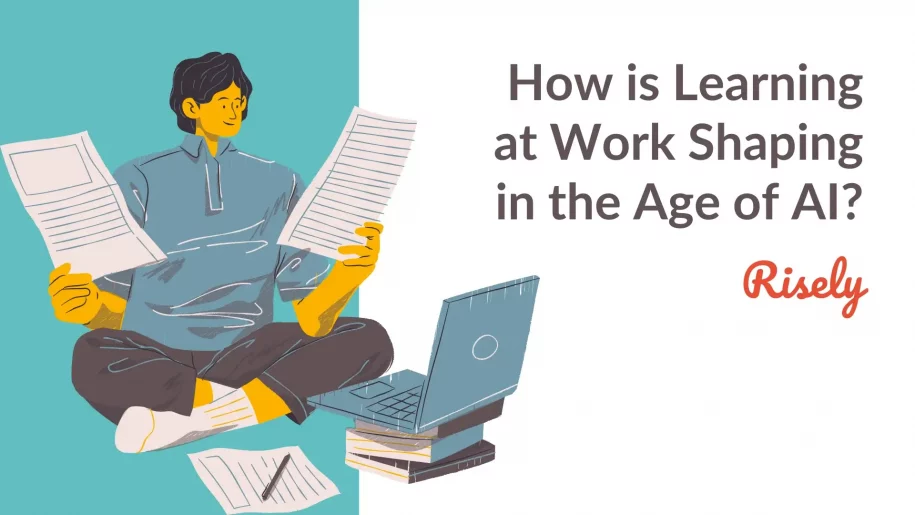How is Learning at Work Shaping in the Age of AI?
The traditional way of learning at work is changing fast because of AI. This change allows companies to improve how they teach and develop their staff. By using AI, you can make learning experiences more effective, personal, and engaging for your employees. But exactly how? In this blog, we will look into several ways to integrate AI into your L&D processes and initiatives so that 2025 turns into an AI-mazing year of learning at work.Where’s AI in learning at work today?
But before we begin, let’s set some context. AI in learning and development at work is not simply about adding an LLM to your workflow. There are more comprehensive solutions that can unlock massive value for your team. Since several organizations are turning into early adopters, there’s a lot of enthusiasm and expectations about what AI brings. As the change leader in this scenario, it becomes imperative for you to understand what AI can and cannot do and communicate these ideas effectively to the stakeholders around you, like the C-suite and the employees involved in learning programs. AI is changing how we help employees grow. It provides helpful data, automates tasks, and offers tailored learning experiences. This technology helps HR and L&D leaders and employees make better choices for their career paths. It connects personal goals with what the organization needs. But that’s not the end of the story. AI’s effect on employee development goes beyond just learning new skills. It’s also about building a culture of ongoing growth. It gives employees the tools they need to reach their full potential, which they might not have been able to access earlier. As a result, this leads to more job satisfaction, higher productivity, and a more engaged and motivated workforce.Is AI going to replace people at work? What can L&D do about this anxiety?
A big worry about AI is that it might eliminate jobs. But we can reduce this worry by actively helping employees learn new skills. As Steve Hunt mentioned in a recent podcast episode with Risely, every technology that eliminates some jobs creates many more. We are undergoing a fundamental shift in the purpose and meaning of work for society at large.- Finding skill gaps and offering specific learning opportunities
- Fostering a culture of learning at work and professional development
- Motivating employees to take on new technologies and grow their skills
5 Ways to add AI to learning at work in 2025
Learning at work has changed a lot. We no longer stick to one-time training events. Instead, we are moving toward a continuous learning approach. When you embrace continuous learning, you can:- Encourage innovation and speed by creating a culture of constant improvement
- Build a workforce ready for the future that can handle rapid tech changes
- Improve employee engagement and keep them by investing in their growth
#1 Build personalized learning experiences
AI creates personalized learning paths for employees. It makes them feel more confident and addresses their different learning needs, which cookie-cutter programs offered so far may overlook. For example, Risely, the AI co-pilot for people managers, offers a dynamic learning journey that fits the unique context of every people manager. The challenges of leaders and managers are diverse and affected by many factors, an AI can match this array of needs by identifying which areas need more support and when. This tailored approach keeps employees engaged with content that fits their needs. It leads to better knowledge retention and skill development. The outcome is a more confident workforce that can help the organization succeed.#2 Democratize access to learning in your organization
How many people can you meaningfully train in your entire organization? For most L&D teams, the number isn’t huge. Moreover, since many learning at work opportunities run in cohorts, employees must wait before getting help. It means letting the problems arising due to lack of skill development pester for a long, and at times, they grow into bigger troubles. For instance, if a manager is bad at delegating and has to pass six months before they can get training, their entire team will face overburdening work for that time. Meanwhile, more challenges like turnover due to tight deadlines and heavy workloads become prominent. Adding an AI coach like Merlin to this manager’s learning and development plan will help cut down on the problem. It will help the manager access support and help in a way that fits their unique needs, such as the challenges with a couple of specific team members. Similarly, an AI coach can reach hundreds of managers without the L&D team needing to scale up operations and having multiple leadership coaches on the roaster. It’s also a great way to reduce challenges arising from geographical and time zone differences among workplaces.#3 AI-driven analytics for tracking learning progress
AI-powered analytics give L&D leaders useful insights about employee growth and how well learning programs work. By monitoring learning progress and engagement, AI can find out where employees are doing well or having difficulties.This approach, based on data, helps HR leaders to tailor learning help, offer specific support, and see how learning actions affect the entire organization. AI-driven analytics makes sure that learning programs match business goals and help the company’s overall success.
Other Interesting Reads
#4 Enhance employee engagement through gamified learning experiences
Integrating fun and game-like features into learning experiences helps improve employee satisfaction. This method encourages a culture of workplace learning. AI-powered platforms use elements like challenges, rewards, and leader boards to motivate workers and make learning enjoyable. For example, Risely uses daily nudges as a microlearning pathway for leadership development. It shares a small actionable insight to support a small bit of progress toward each manager’s specific challenges. By using these game-like features, employees can remember what they learn better. It also creates a friendly competition and teamwork among them. By adopting AI for gamified learning, companies can make the learning process more fun and effective. This plays a critical role in increasing employee engagement and satisfaction.#5 Improve skills gap analysis with AI’s predictive abilities
Another interesting use case that L&D professionals can explore with AI’s abilities is improving the skills gap analysis for their teams. The conventional skills gap analysis exercise takes time and resources. Ultimately. this exercise offers us a list of skills and competencies that the team needs to build in order to fit in. But what if, we could figure out what the team needs to succeed in the future? The predictive abilities of AI can forecast what skills would be in demand soon. That way, you are not just chasing after what has already happened. Instead, you can make the first move in the industry and build a competitive edge. For example, let ‘s assume you are leading L&D for a retail chain. With the help of AI for learning at work, you can:- Identify emerging skill trends in the retail industry
- Predict potential skill obsolescence
- Anticipate technological and market changes that will impact required skills
Wrapping Up
AI is changing how we learn. Many new tools and platforms are now available. They help organizations improve their learning and development programs. These AI-driven solutions offer personal learning experiences, automate tasks, and provide insights based on data. There are many options, like platforms that adapt to each learner and mentorship programs that use AI. Organizations must assess their needs and pick the tools and platforms that match their learning goals and objectives in effective ways. In conclusion, using AI in workplace learning is not about taking over human skills but making them better. AI gives people personalized learning, helps them gain new skills, and supports their growth. By using AI, companies can build a culture where learning never stops. Employees get to play fun games and benefit from helpful AI insights. We can check how well AI learning programs work through set goals and feedback to keep improving. As we move into the AI age, it is important to use the right AI tools, fit them into what we already have, and keep an eye on future trends in AI and workplace learning. Welcome this change to make a more lively and employee-focused learning space.Turn your L&D plans into reality with Risely’s easy to apply templates!
Grab your free copy of Risely’s learning and development strategy framework and get started.
How to Build a Leadership Journey? ft. Thomas Ulbrich
Effective leadership doesn’t always begin with a grand vision. Sometimes, it takes root in the courage to take the first…
AI and Leadership Development: Driving Synergy for Growth
AI and Leadership Development: Driving Synergy for Growth You know the frustration all too well. Your organization invests thousands in…
How Are AI Learning Platforms Transforming Leadership Development?
As an L&D leader, you’re likely familiar with this frustrating reality: 82% of organizations consider leadership development critical(1), yet only…
5 Essential AI Skills for L&D Leaders
5 Essential AI Skills for L&D Leaders According to LinkedIn’s 2025 Workplace Learning Report(1), 71% of L&D professionals are now…
How to Create a Course with AI: A Guide for L&D Professionals
How to Create a Course with AI: A Guide for L&D Professionals According to a McKinsey survey(1), only 11% of…


